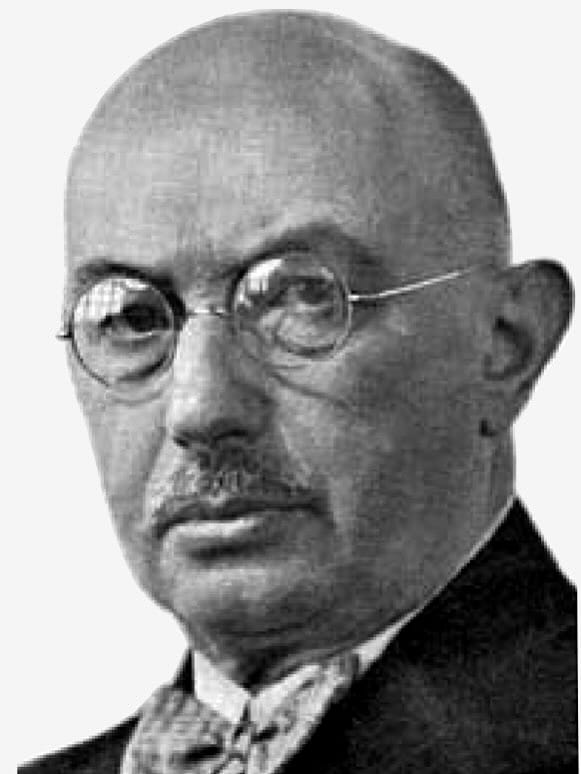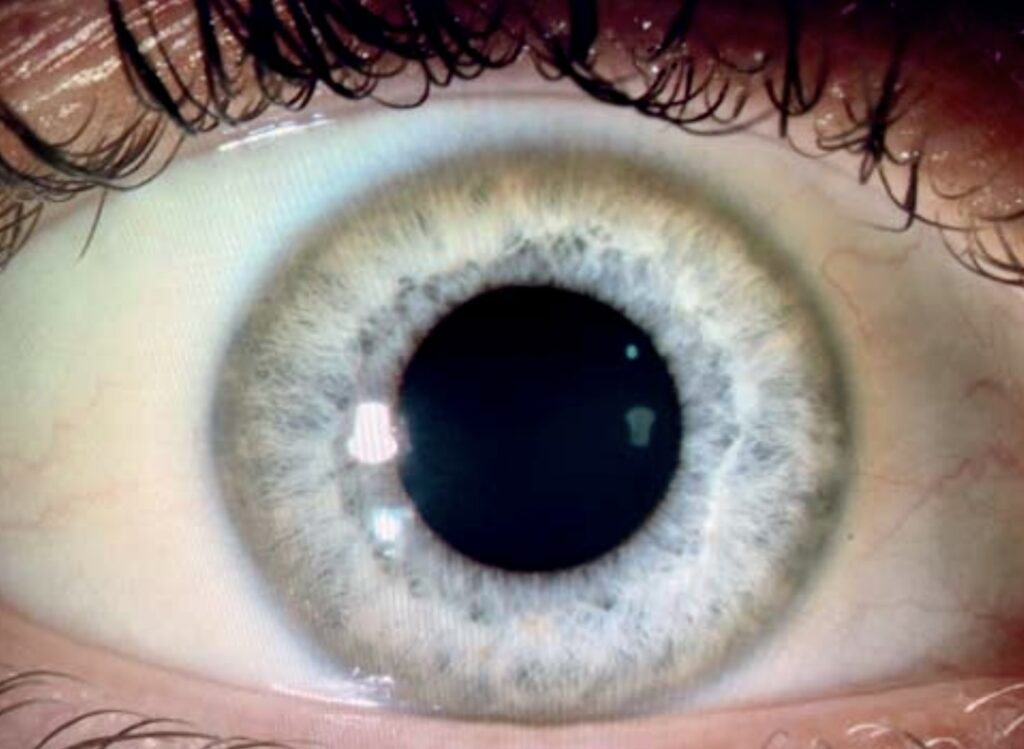Bruno Fleischer

Otto Bruno Fleischer (1874-1965) was a German ophthalmologist.
Fleischer was an ophthalmologist and pathologist best known for his description of the corneal pigmentation later termed the Kayser–Fleischer ring, a key diagnostic feature of Wilson’s disease. His careful clinical and histopathological work in the early 20th century established a link between ocular findings and systemic neurological disease.
Fleischer studied medicine in Leipzig, Heidelberg, and Munich, earning his doctorate in 1898. He trained under the eminent pathologist Max Schultze and ophthalmologist Theodor Leber, developing a lifelong interest in the microscopic study of ocular tissue. Fleischer documented corneal discolouration in patients with hepatic and neurological symptoms publishing his detailed observations in 1903 under the title Zwei weitere Fälle von Pseudosklerose (Westphal). His interpretation, that the pigmentation represented silver deposition, reflected prevailing theories of the time.
Biographical Timeline
- Born on May 2, 1874 at Stuttgart
- 1893–1898: Studied medicine at the Universities of Tübingen, Geneva, and Berlin.
- 1898 – Received his Dr. med. degree from Tübingen with a dissertation on ocular pathology; appointed assistant at the University Eye Clinic, Tübingen.
- 1903 – Published landmark observation of a brown-green corneal ring in patients with hepatic cirrhosis and neurological symptoms (Kayser–Fleischer ring). Later recognized as part of Wilson disease .
- 1904 – Completed habilitation in ophthalmology at Tübingen.
- 1906 – Described iron deposition at the corneal periphery in keratoconus (Fleischer ring)
- 1909 – Appointed extraordinary professor (außerordentlicher Professor) of ophthalmology, Tübingen.
- 1914–1918: Served as a medical officer during the First World War.
- 1920 – Professor and Chair of Ophthalmology at the University of Erlangen-Nürnberg, succeeding Gustav Schleich.
- 1934 – Published his final paper on corneal pigmentation in hepatic and neurological disease, consolidating his earlier findings.
- 1951 – Retired (emeritiert) from Erlangen.
- Died March 26, 1965 at Erlangen, Germany, aged 90.
Medical Eponyms
Kayser-Fleischer Ring (1902, 1903)
A golden-brown or greenish-brown corneal ring at the level of Descemet’s membrane, caused by copper deposition in the cornea. It is a cardinal sign of Wilson’s disease (hepatolenticular degeneration)

1902 — Bernhard Kayser (1869-1954) first reported a “greenish discoloration of the cornea” in a 23-year-old man with multiple sclerosis, calling it an angeborene grünliche Verfärbung der Kornea (“congenital greenish pigmentation”). He proposed it was congenital, describing:
«Die Hornhaut erscheint hier undurchsichtig und von dunkelgrünbrauner Farbe… eine Anhäufung feiner gelber Flecken ganz nahe an der Hinterwand.»
Kayser, 1902
“The cornea appears opaque and of a dark greenish-brown colour… an accumulation of fine yellow spots close to the posterior surface.”
1903 — Bruno Fleischer (1874-1965), in his paper “Zwei weitere Fälle von grünlicher Verfärbung der Kornea”, described two additional cases. He confirmed the ring’s location in the deep peripheral corneal layers (Descemet’s membrane) and noted it appeared in patients with pseudosclerosis (now Wilson disease). He questioned Kayser’s idea of a congenital cause and excluded silver ingestion (“Argentum nitricum innerlich wurde nicht gebraucht”).
«Bei beiden Kranken fand sich ein schmaler, grünlich-brauner, ringförmiger Streifen am Hornhautrand, im Bereiche der Descemetschen Membran…»
Fleischer, 1903
“In both patients there was a narrow greenish-brown ring at the margin of the cornea, in the region of Descemet’s membrane”
1934 — Werner Gerlach and Wilhelm Rohrschneider published the pivotal study disproving silver as the pigment’s basis. Using spectrographic analysis, they found the corneal ring to be “silberfrei… dagegen findet sich eine Spur Kupfer” (“free of silver, but containing a trace of copper”). This was the first definitive identification of copper as the deposited element, cementing the modern understanding of Wilson’s disease as a disorder of copper metabolism.
This pivotal observation disproved the earlier “silver” theory of Kayser and Fleischer, confirming that copper accumulation from impaired biliary excretion in Wilson’s disease caused the pathognomonic ring.
Fleischer ring (1906)
A brown or olive-green iron-pigment ring encircling the base of the corneal cone in keratoconus. A classic diagnostic sign of keratoconus best visualised with slit-lamp and cobalt-blue filter after fluorescein staining.
1906 – Fleischer described fine, granular pigmentation within the epithelial basement membrane (Bowman’s layer) in patients with keratoconus and hypothesised haemosiderin deposition as the cause.
«Ein feiner, gelblich-brauner Saum von Pigmentkörnchen liegt an der Basis des Hornhautkegels; er markiert die Grenze zwischen normalem und konischem Gebiet.»
Fleischer, 1906
“A fine yellow-brown band of pigment granules lies at the base of the corneal cone, marking the border between normal and conical areas.”
Controversies
Eponymous confusion and mistaken identity
Bruno Fleischer (1874–1965), the ophthalmologist has long been confused with Munich internist Richard Fleischer (1848–1909) known for describing march haemoglobinuria.
As Dening and Berrios (1990, The Lancet) documented, at least seven major medical dictionaries in the 20th century incorrectly attributed the corneal pigmentation finding to Richard Fleischer or misdescribed Bruno as a “Munich physician who died in 1904.” This confusion persisted for decades and extended to attribution of the wrong portrait photo, most commonly this image of Richard Fleischer (without the captions…)
Archival records (Stuttgart birth registers, 1874) confirm that his full name was Otto Bruno Fleischer, son of Bruno Fleischer and Mathilda Gottschalk. The combination of multiple “Fleischers” in medical and public life, overlapping initials, and absent photographic documentation likely contributed to the longstanding eponymous mix-up.
Major Publications
- Fleischer B. Zwei weiterer Falle von grunlicher Verfarbung der Kornea. Klinische Monatsblätter für Augenheilkunde 1903; 41: 489-91 [Kayser-Fleischer Ring]
- Fleischer B. Über Keratokonus und eigenartige Pigmentbildung in der Kornea. Münchener medizinische Wochenschrift. 1906; 53(1): 625–626. [Fleischer ring]
- Fleischer B. Die Entwicklung der Tränenröhrchen bei den Säugetieren. Graefes Arhiv für Ophthalmologie 1906; 62, 379–399
- Fleischer B. Die periphere braun-grünliche Hornhautverfärbung als Symptom einer eigenartigen Allgemeinerkrankung. Münchener medizinische Wochenschrift 1909; 56: 1120–1123
- Fleischer B. Über eine eigenartige bisher nicht bekannte Hornhauttrübung (ein Hinweis auf die normale Struktur der Hornhaut?). Graefes Arhiv für Ophthalmologie, 1910; 77(1): 136-140.
- Fleischer B. Uber eine der ’Pseudosklerose’ nahestehende bisher unbekannte Krankheit (gekennzeichnet durch Tremor, psychische Storungen, braunliche Pigmentierung bestimmter Gewebe, insbesondere auch der Hornhautperipherie, Lebercirrhose). Deutsche Zeitschrift für Nervenheilkunde 1912; 44(3): 179-201. [KF Ring neuro-psychiatric association][English translation]
- Fleischer B. Zur Frage des Hamosiderinrings bei Keratokonus. Klinische Monatsblätter für Augenheilkunde 1916; 57: 353-61. [Corneal pigmentation in keratoconus – Fleischer ring]
- Fleischer B. Über myotonische Dystrophie mit Katarakt. Graefes Archiv für Ophthalmologie 1918; 96: 91–133
- Fleischer B, Gerlach W. Zur Frage der Silberpigmentierung des Kayser-Fleischerschen Hornhautringes. Klinische Wochenschrift 1934; 13(7): 255. [Kayser-Fleischer Ring]
- Fleischer B. Über epitheloidzellige Granulomatose. Graefes Archiv für Ophthalmologie 1941; 143, 435–455
References
Biography
- Schmelzer H. Proffessor Dr. Bruno Fleischer zum Gedächtnis [In memoriam Prof. Dr, Bruno Fleischer]. Klin Monbl Augenheilkd. 1965 Oct;147(2):264-5.
- Dening TR, Berrios GE. Eponymous confusion over Bruno Fleischer. Lancet. 1990 Feb 3;335(8684):291.
- Rohrbach JM, Lang GE. 1902/1903, Bernhard Kayser und Bruno Fleische. Klin Monbl Augenheilkd 2013; 230(4): 310-312
- Fleischer, Otto Bruno. Deutsche Biographie
- Fleischer, Bruno. Katalog der Deutschen Nationalbibliothek
Eponymous Terms
- Siemerling E, Oloff H. Pseudosclerose (WestphalStrumpell) mit cornealring (Kayser-Fleischer) under doppelseitger scheinkatarakt, die nur bei seitlicherbeleuchtung sichtbar ist und die, der nach verletzung durch kupfersplitterentstehenden katarakt ahnlich ist. Klinische Wochenschrift 1922; 1: 1087–1089.
- Gerlach W, Rohrschneider W. Besteht das Pigment des Kayser-Fleischerschen Hornhautringes aus Silber? Klinische Wochenschrift. 1934;13(2):48-49
- Gass JDM. The iron lines of the superficial cornea; Hudson-Stahli line, Stocker’s line and Fleischer’s ring. Arch Ophthalmol 1964; 71:348–358
- Fleischer B, Dening TR, Dening RG. Concerning a hitherto unknown disease resembling pseudosclerosis. History of Psychiatry. 1990; 1(4): 403-406 and 406-418
- Rohrbach JM. Vom Sinn und Unsinn ophthalmologischer Eponyme. Klin Monbl Augenheilkd 2015; 232(02): 193-195
- Kriszt Á, Losonczy G, Berta A, Takács L. Presence of Fleischer ring and prominent corneal nerves in keratoconus relatives and normal controls. Int J Ophthalmol. 2015 Oct 18;8(5):922-7.
- Bigdon E et al. Kayser-Fleischer-Ring – kann eine frühe Diagnosestellung den Krankheitsverlauf von Morbus Wilson verbessern? Klin Monbl Augenheilkd 2020; 237(10): 1237-1239
- Dooley JS. The history of Wilson disease. Clin Liver Dis (Hoboken). 2024 Jul 5;23(1):e0238
Eponym
the person behind the name
BM BCh, Oxford University. Currently training in Australia. Career interest in Hepatology and Emergency Medicine
BA MA (Oxon) MBChB (Edin) FACEM FFSEM. Emergency physician, Sir Charles Gairdner Hospital. Passion for rugby; medical history; medical education; and asynchronous learning #FOAMed evangelist. Co-founder and CTO of Life in the Fast lane | On Call: Principles and Protocol 4e| Eponyms | Books |

